
About UsThe Numismatic Bibliomania Society is a non-profit organization promoting numismatic literature. For more information please see our web site at coinbooks.org SubscriptionsThose wishing to become new E-Sylum subscribers (or wishing to Unsubscribe) can go to the following web page link MembershipThere is a membership application available on the web site Membership Application To join, print the application and return it with your check to the address printed on the application. Membership is only $15 to addresses in the U.S., $20 for First Class mail, and $25 elsewhere. For those without web access, write to: David M. Sundman, Secretary/TreasurerNumismatic Bibliomania
Society AsylumFor Asylum mailing address changes and other membership questions, contact David at this email address: dsundman@LittletonCoin.com SubmissionsTo submit items for publication in The E-Sylum, just Reply to this message, or write to the Editor at this address: whomren@coinlibrary.com
BUY THE BOOK BEFORE THE COINYou won't regret it! |
- WAYNE'S WORDS: THE E-SYLUM JUNE 3, 2012
- SKLOW NUMISMATIC LITERATURE SALE #16 RESULTS
- KOLBE & FANNING SALE #125 CLOSES THURSDAY
- NEW BOOK: A GUIDE BOOK OF MORGAN SILVER DOLLARS, 4TH EDITION
- NEW BOOK: IDENTIFICATION OF 2X2 ENVELOPES
- NEW BOOK: COIN CHEMISTRY, 3RD EDITION
- LIA MEISSNER 1936-2012
- QUERY: "ALL THE THINGS WHICH ARE"
- MORE ON VINCENT W. ALONES
- QUERY: WAS THERE LEGAL ACTION REGARDING LONGINES SYMPHONETTE MEDALS?
- MORE ON THE ABNCO PORTRAIT OF ALEXANDER II
- NOTES FROM E-SYLUM READERS: JUNE 3, 2012
- THE NEW-YORK HISTORICAL SOCIETY: RESPECT THE HYPHEN!
- OBAMA AWARDS MEDALS OF FREEDOM
- ARTICLE INTERVIEWS HOBO NICKEL COLLECTION BUYER
- 2012 MEMPHIS INTERNATIONAL PAPER MONEY SHOW SPEAKERS
- COINS LEFT ON HEADSTONES
- ARTICLE HIGHLIGHTS WEST POINT FIRST SALUTE SILVER DOLLAR TRADITION
- ALEXANDER HAMILTON, FEDERALIST HUNK
- CANADIAN CHARITIES CHASING CLOSETED CENTS
- EAST INDIA COMPANY SELLING DIAMOND-ENCRUSTED COINS FOR QUEEN'S JUBILEE
- ARTICLE HIGHLIGHTS MINNESOTA ELONGATED CENTS
- FEATURED WEB SITE: THE GLOBAL PHILATELIC LIBRARY
WAYNE'S WORDS: THE E-SYLUM JUNE 3, 2012

New subscribers this week include Ernie Montgomery, Ben Costello and Jim Motley. Welcome aboard! We have 1,547 email subscribers.
This week we open with updates on the last and next major U.S. numismatic literature sales and information on three new books. Other topics include Colombian numismatist Lia Meissner, Vincent Alones, the Medal of Freedom, Hobo Nickels, and elongated cents.
To learn more about coin chemistry, 2x2 coin envelopes, Rittenhouse's Transit of Venus, official counterfeiting and the sexiest stud on U.S. paper money, read on.
Have a great week, everyone!
SKLOW NUMISMATIC LITERATURE SALE #16 RESULTS
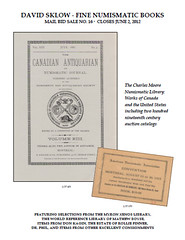 Lot 5 - Bowers & Ruddy Deluxe presentation of the Adams Sale $900.
Lot 5 - Bowers & Ruddy Deluxe presentation of the Adams Sale $900.
Lot 22 - Bound Frossard Catalogs - Chapman Brother Bid Books $2005.
Lot 211 - Rollie Finner's 50 Year ANA Gold Medal $990.
Lot 440 - The Canadian Coin Cabinet by Leroux $550.
Lot 668 - 1924 ANA Photograph $990
Lot 680 - ANS 1858 Constitution & By-laws $899
Lot 901 - Plated Scott Stamp & Coin Catalog June 1895 - $1100.
Lot 944 - George Kolbe bound presentation sale No.1 $660. [received the highest number of bids in the sale].
Note: Numerous items in the Charles Moore Library received great attention from our neighbors to the north, numismatic literature is alive & well in Canada!
David Sklow-Fine Numismatic Books
P.O. Box 6321
Colorado Springs, CO 80934
PH: 719-302-5686
FAX: 719-302-4933
EMAIL: numismaticbooks@aol.com
WEB: FineNumismaticBooks.com
KOLBE & FANNING SALE #125 CLOSES THURSDAY
 Kolbe & Fanning wish to remind our clients that our 125th mail-bid sale of important numismatic literature will close on Thursday, June 7. The sale features selections from the libraries of F. Gordon Frost, David J. Davis and a major coin firm, and includes significant works in virtually all areas of numismatic study.
Kolbe & Fanning wish to remind our clients that our 125th mail-bid sale of important numismatic literature will close on Thursday, June 7. The sale features selections from the libraries of F. Gordon Frost, David J. Davis and a major coin firm, and includes significant works in virtually all areas of numismatic study.
The catalogue is available for downloading from the Kolbe & Fanning website at www.numislit.com. We invite bidders to peruse the catalogue carefully andlet us know of any questions they may have. The sale includes an excellent variety of works and has been generating a good deal of enthusiasm.
Bids may be placed by post, email, phone or fax. Please contact David Fanning at:
phone +1 (614) 414-0855
fax +1 (614) 414-0860
email df@numislit.com
Again, the catalogue is available at www.numislit.com. We look forward to your participation.
NEW BOOK: A GUIDE BOOK OF MORGAN SILVER DOLLARS, 4TH EDITION
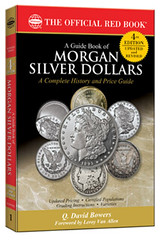 Whitman Publishing, LLC, is releasing the fourth edition of A Guide Book of Morgan Silver Dollars, completely updated and with a new chapter on error and misstruck coins. The 304-page book, by Q. David Bowers, offers pricing, grading instructions, series history, and tips on how to build a high-quality collection. It will be available June 28, 2012.
Whitman Publishing, LLC, is releasing the fourth edition of A Guide Book of Morgan Silver Dollars, completely updated and with a new chapter on error and misstruck coins. The 304-page book, by Q. David Bowers, offers pricing, grading instructions, series history, and tips on how to build a high-quality collection. It will be available June 28, 2012.
"Americans love to collect the Morgan silver dollar," said Whitman publisher Dennis Tucker. "No other U.S. coin captures the popular imagination so well. It conjures up the romance of the Old West, cowboys and riverboat gamblers, silver miners, and old-time politics, spanning some of the most dramatic years in American history, from 1878 to 1921."
In this fourth edition of his best-selling book, Bowers (the "Dean of American Numismatics") offers an engaging portrait of the country's most popular classic coin.
Readers learn what to look for when they buy, how to grade their coins, how to cherrypick valuable rare varieties that appear normal at first glance, and how to be a smart buyer. A Guide Book of Morgan Silver Dollars, fourth edition, includes a thorough market analysis for each date and mintmark, a detailed look at the minting process, and a study of Treasury releases and other hoards. A section on U.S. Mint pattern coins shows various coin designs that "might have been," which ultimately led to Morgan's final motif. And the new section on error and misstruck Morgan dollars discusses rare double-struck and off-center coins, and other numismatic oddities.
"It is an exciting time to be collecting Morgan dollars," writes silver-dollar specialist Leroy Van Allen in the foreword. "David Bowers's book will give you the knowledge to have fun and maybe also reap some profits."
A Guide Book of Morgan Silver Dollars, fourth edition, is available for preorder online from Whitman.com and other book retailers, and can be purchased from hobby shops and bookstores nationwide on June 28, 2012.
304 pages, 6 x 9 format
Softcover
Fully illustrated in color
Retail $19.95
By Q. David Bowers; foreword by Leroy Van Allen
For more information, or to order, see: whitman.com/Inventory/Detail/A-Guide-Book-of-Morgan-Silver-Dollars-4th-Edition+0794836852
NEW BOOK: IDENTIFICATION OF 2X2 ENVELOPES
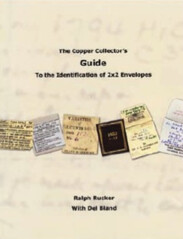 Today, niche specialties are as strong as ever. One of the most obscure, yet interesting, of such came to my attention recently when I received in the mail a nice book, color-illustrated and on fine paper, The Copper Collectors Guide to Identification of 2x2 Envelopes, by Ralph Rucker with the assistance of Del Bland (long-time copper cent specialist).
Today, niche specialties are as strong as ever. One of the most obscure, yet interesting, of such came to my attention recently when I received in the mail a nice book, color-illustrated and on fine paper, The Copper Collectors Guide to Identification of 2x2 Envelopes, by Ralph Rucker with the assistance of Del Bland (long-time copper cent specialist).
Many of you remember the small paper envelopes with the flap, measuring 2 inches by 2 inches, that were the standard of the hobby in the 20th century. They are still seen now in some instances, but they are increasingly rare.
Go back to a coin show 30 years ago and cases would be filled with paper envelopes with coins sitting on top. Today a case can be filled side to side with plastic slabs without a piece of paper in sight.
Ralph spent 147 pages illustrating paper envelopes used over the years by different collectors and dealers. Most of these bear hand-written inscriptions, but others are typed.
The study begins with John W. Adams, whose superb collection of 1794 cents was sold by my firm Bowers and Ruddy Galleries back in 1982. Since then, John has been a fine friend. His envelopes on yellow stock are carefully hand lettered.
Those of Willard C. Blaisdell, a collector from New Jersey who was a familiar at conventions in the 1950s and 1960s, feature a general description on the top line, Sheldon attribution (Early American Cents and later, Penny Whimsy by William H. Sheldon), grade and a pedigree.
Walter Breen wrote in pencil on his envelopes, information about the variety, die state, and rarity.
These paper envelopes themselves have little monetary value to anyone other than a copper cent specialist. But, how interesting they are to contemplate! I personally knew or still know the vast majority of the envelope writers.
To read the complete article, see: Specialized field, indeed - Book focuses on 2 by 2 holders (www.coinworld.com/articles/specialized-field-indeed/)
NEW BOOK: COIN CHEMISTRY, 3RD EDITION
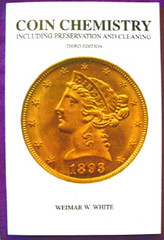 My publisher is now selling the third edition of my book entitled
Coin Chemistry. It has three additional articles in it. The
2nd edition was a best seller but this latest edition will be my
last edition. It has a soft cover and a very attractive 1893-CC
Gold Half Eagle pictured on the cover. The book I understand
will sell for less than $13. This would be a great addition to
your library or a nice gift to present to your collector friends.
My publisher is Dave Aultman and he can be reached at 1-585-
924-4250, ext. 300.
My publisher is now selling the third edition of my book entitled
Coin Chemistry. It has three additional articles in it. The
2nd edition was a best seller but this latest edition will be my
last edition. It has a soft cover and a very attractive 1893-CC
Gold Half Eagle pictured on the cover. The book I understand
will sell for less than $13. This would be a great addition to
your library or a nice gift to present to your collector friends.
My publisher is Dave Aultman and he can be reached at 1-585-
924-4250, ext. 300.
[Editor's Comment: Weimar's book is very useful and should be in every collector's library. Among other items, he discusses techniques for safely removing harmful contaminates from a coin's surfaces. I can attest to the merits of these techniques as I have used them as detailed in the second edition to remove heavy, thick tarnish from some unattractive coins.]
KOLBE & FANNING NUMISMATIC BOOKSELLERS
LIA MEISSNER 1936-2012
LIA MEISSNER nee Steuer, Born May 14. 1936 succumbed to Emphysema on May 14, 2012 at her home in Bogota, Colombia with her two sons at her side.
Lia moved with her family to Bogota, from Roumania in April 1940 escaping World War II. She married Peter Meissner on April 19th, 1958 and had two sons, Antonio and Robert.
Lia became interested in coins and collecting in 1965 as she had some coins her father, who for business traveled throughout the world, had given her as a child. (a personal story from the two sons is attached to this obituary to illustrate how children can influence parents)
Shortly after her early encounter with the different coins of Colombian origin, as well as the rest of the world, she traveled to New York to learn more about collecting. She found near her hotel the offices of STACK's in midtown NYC, went to visit and met with Norman Stack. He discussed with her about collecting and the idea of not trying to collect the world at one time, but specialize if she could. Her Present Homeland, Colombia had a lengthily history, economically as well as traditional, and she already had a interest in her country.
Lia started to collect in earnest, putting together series of coins by ruler, mint and mint masters of Colombia and the mother country of Spain. Wherever she traveled with Peter, she visited coin shops, hock shops and various vendors as well as being invited to visit museum and collections World Wide.
Her knowledge of the series was so extensive, and collection so detailed, that it came the subject of various reference text and numismatic papers published in Colombia as well as throughout the world. As she traveled often to New York, she always remembered Norman and of course Harvey and Ben, as well as Harvey's son Larry who always tried to be of help to her, bid for her at auctions and find difficult coins to enhance her collection. Through the Stack Family she met Mortimer Hammel, who was considered one of the great experts of Latin American Coinage, and they exchanged ideas, which helped both grow more complete information and collections.
Lia was a long time member of the American Numismatic Association, the American Numismatic Society, and a number of international Societies, Associations and Clubs, in order to keep enhancing her knowledge and still build a outstanding collection.
Lia came to the United States often to attend the ANA Convention, the International Convention and Auctions in order to expand her coins or improve the quality of what she had.
She exchanged letters, papers and ideas with collectors who were interested in Coins of Colombia, and provided great research and history to all who called upon her for assistance.
The Numismatic World has lost a great friend, student, collector and one who encouraged collecting whenever she met with those who shared her dedicated interest in the Hobby.
The Stack Family will miss her greatly.
QUERY: "ALL THE THINGS WHICH ARE"
Roger Burdette writes:
Do any E-Sylum subscribers know of any British medals or coins with an edge inscription reading (in part): "all the things which are" ? The quote is probably from the Christian Bible's book of Revelations, but so far I've been unsuccessful in finding the medal/coin. The inscription is on a photo of a 6-segment edge collar.
MORE ON VINCENT W. ALONES
Jim Grim writes:
Vinny was one of my best friends for the last 10 years, he also helped me write my first book Long Island Coin Club Tokens & Medals".
Here's an excerpt from the book:
This book is dedicated to all the members of the Long Island Coin Club past and present. It has been a lot of fun hanging out with Vinny & Agnes Alones. Sitting there and listening to all the old stories while Vinny searched file after file to come up with another piece of information for this book. He found the original signed membership applications and letters dated in the 1950's asking where the LICC meets and how to join.
He would tell me a story of each member as we added his or her name and membership number to the list. I mean in detail, when they joined, what they collected, when and what they won at each and every ANA convention and any other awards they received. Also each and every ANA convention they attended and how they got there and who they were with and where they stayed and what they ate. It was just simply amazing that he could remember 40 years of ANA conventions, 50 years of LICC history and 20 years of the Grand Central Coin Conventions like they were yesterday. Agnes & I would sit there and listen to story after story and Agnes would remind Vinny of a few more details and another story would come out.
The LICC was started in 1952 by only a few but by the 1960's & 70's became a large organized club. Their dedication to the hobby and to the club, lead to the hosting the Grand Central Coin Convention and 2 ANA conventions. Not only did they attend 40 years of ANA conventions. They were very active in all aspects, displaying, judging, welcoming, hosting and won many accolades along the way. If you visit the new ANA's hall of fame you can fine many of the members names among the elite.
Jim Grim adds:
Larry Gentile made 50 of this note to be used at the YN program for the Nov. 6, 1983 Grand Central Coin Convention, with Vincent Alones as he guest numismatic personality.
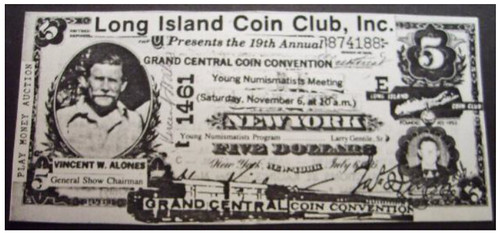
To read the earlier E-Sylum article, see: VINCENT W. ALONES, 1916 - 2012 (www.coinbooks.org/esylum_v15n22a08.html)

QUERY: WAS THERE LEGAL ACTION REGARDING LONGINES SYMPHONETTE MEDALS?
David T. Alexander writes:
I read with interest the readers' recollections of the Longines Symphonette medals of some years ago. You may file the following recollection under "unverified or unedited memory," but I clearly recall this report from my first year on staff at Coin World, 1974. The Franklin Mint was then approaching its apogee and there was much debate over claims of "investment value and treasured heirloom" status attributed to several private mint issues, claims that Franklin Mint was NOT making. Word in the office was that such claims in advertising were now absolutely taboo, because Longines had made them and had been slapped with vigorous Federal legal action, possibly a Federal Trade Commission investigation that made the firm quit the medal-hustling business abruptly and for good. Something triggered by loudly disgruntled buyers who had attempted to cash in on the "investment" value to their great dissatisfaction. Perhaps other E-Sylum readers may recall some more details.
To read the earlier E-Sylum article, see: MORE ON LONGINES SYMPHONETTE MEDALS (www.coinbooks.org/esylum_v15n18a12.html)
MORE ON THE ABNCO PORTRAIT OF ALEXANDER II
Gene Hessler writes:
The image of Alexander II, that has been discussed recently was the frontispiece for a presentation book to Alexander II in 1861 from American Bank Note Company. The book resides in the Hermitage where Bill Barrett was fortunate to examine and photograph the contents. Bill provided the photos and I wrote about this presentation book in PAPER MONEY No. 215 (A Gift for a Czar) in 2001. Bill Barrett wrote an introduction to the article.
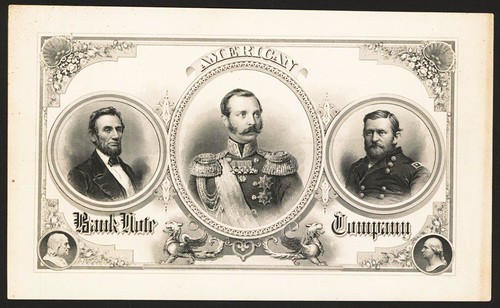
Mark Tomasko writes:
Regarding the Russian portrait on the ABN card, a die proof and/or ABN engraving records answer the question. Attached is a scan of the die proof, with the title "Alexander II" beneath the portrait. This proof is in a book of ABN portraits done for the president of ABN. It was engraved by James Bannister, a very good picture engraver for ABN whose specialty was portraits. It is die number 65 in the original series of portraits done by ABN starting in 1858. The only use I have seen of it is on the card you illustrate, which was one of the plates in the 1869 promotional book ABN produced. The portrait was done around the time of the very unusual sale ABN made to Russia in 1859 (detailed in my book) and was probably used in a presentation album at that time, perhaps the one that survives today in Russia. The portrait seems to be in the category of a "thank you" job (as they call it in the bank note industry), to honor and curry favor with a major customer. For example, ABN did a couple of unusual, large portraits of Chinese nationalist officials in the 1940s that would fall into the same category.
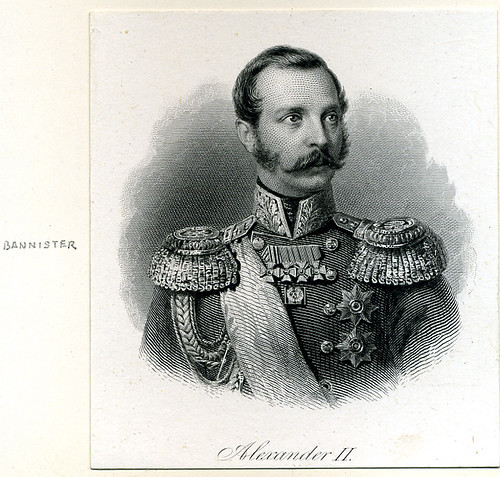
To read the earlier E-Sylum article, see: WHO IS THAT GENT WITH LINCOLN AND GRANT? ALEXANDER II (www.coinbooks.org/esylum_v15n22a13.html)
NOTES FROM E-SYLUM READERS: JUNE 3, 2012
ANA Executive Director Jeff Shevlin
John and Nancy Wilson write:
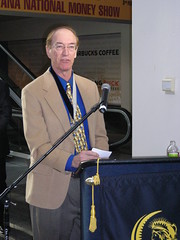 Here are photos we took at the ANA Sacramento NMS in March, 2011. General Chairman Jeff Shevlin is shown at the lectern welcoming everyone to the show and another photo shows him and the Board cutting the ribbon opening the event. We want to thank the ANA Selection Committee and Board of Governors for all their work in the process that selected Jeff Shevlin. When we met Jeff at the Sacramento NMS in 2011 we were impressed at the great job he, along with his committee, did on the convention.
Here are photos we took at the ANA Sacramento NMS in March, 2011. General Chairman Jeff Shevlin is shown at the lectern welcoming everyone to the show and another photo shows him and the Board cutting the ribbon opening the event. We want to thank the ANA Selection Committee and Board of Governors for all their work in the process that selected Jeff Shevlin. When we met Jeff at the Sacramento NMS in 2011 we were impressed at the great job he, along with his committee, did on the convention.
At the ANA Board meeting in Denver he gave an IT Committee report, along with Mr. Perkins, and it was delivered in a professional manner that impressed everyone in attendance. We are very happy that the ANA Board is bringing on board as their Executive Director a true numismatist with very high qualifications. We know that he will show the same passion for ANA, its staff and membership, as he does for So Called Dollars, of which he is an expert in. Good luck Jeff in your new job.
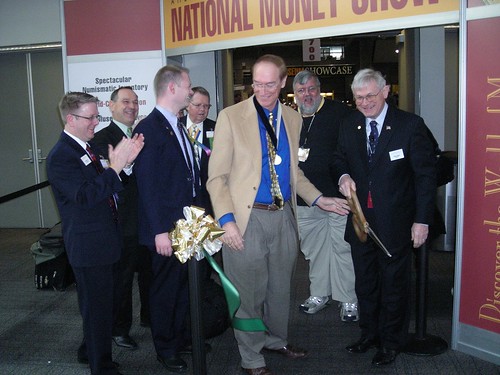
By way of correction a reader sets us straight on the Stack's-Bowers pamphlet mentioned last week:
In last week's issue a contributor noted that a brochure mailed by a certain firm was erroneous in stating that Tom Hallenbeck, president of the ANA, was the "executive director." Some fact checking, always desirable when trying to prove a point or to criticize someone's actions, would have revealed that, in fact, Tom Hallenbeck at the recent ANA Convention in Denver was indeed wearing a badge stating that he was (temporary) executive director. The appointment of Jeff Shevlin as executive director had not yet been announced when the brochure in question went to press. Accordingly, the brochure was 100% accurate at the time it was published.
To read the earlier E-Sylum article, see: ANA APPOINTS AUTHOR JEFF SHEVLIN NEW EXECUTIVE DIRECTOR (www.coinbooks.org/esylum_v15n22a15.html)
To read the complete article, see: http://www.numismaticnews.net/buzz/surprised-by-the-answer (www.numismaticnews.net/buzz/surprised-by-the-answer)
Rittenhouse and the Transit of Venus
Len Augsburger writes:
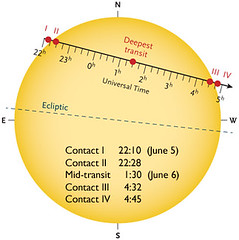 This is only peripherally numismatic, but the 243-year cycle of the transit of Venus occurs next week.
It will be visible to the naked eye in some parts of the world. Numismatic triviists will recall David Rittenhouse's well known observation of the same event in 1769.
This is only peripherally numismatic, but the 243-year cycle of the transit of Venus occurs next week.
It will be visible to the naked eye in some parts of the world. Numismatic triviists will recall David Rittenhouse's well known observation of the same event in 1769.
To read the complete article, see:
Transit of Venus: June 5-6, 2012
(www.skyandtelescope.com/observing/highlights/Transit-of-Venus-February
-2012-134332798.html)
Correction: Prince Edward Island Holey Dollar
Chris Faulkner writes:
To read the earlier E-Sylum article, see: QUERY: COUNTERFEIT PRINCE EDWARD ISLAND HOLEY DOLLARS (www.coinbooks.org/esylum_v15n22a09.html)
THE BOOK BAZARRE
THE NEW-YORK HISTORICAL SOCIETY: RESPECT THE HYPHEN!
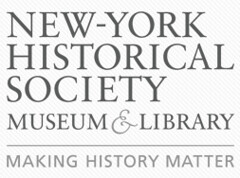 Alan Weinberg gave an excellent report on his visit to a museum in New York City in the last E-Sylum. Trouble is, he got the name of the museum wrong. There is a hyphen in the name New-York Historical Society.
Alan Weinberg gave an excellent report on his visit to a museum in New York City in the last E-Sylum. Trouble is, he got the name of the museum wrong. There is a hyphen in the name New-York Historical Society.
Apparently the organization hotly defends the use of that hyphen in the name. Here is a quote from Louise Mirrer, President and CEO of the Society, who gives a history of that hyphen.
Why did New-York Historical Society decide to keep the hyphen in its name?
The placement of a hyphen between "New" and York" was common usage during our founding in 1804. Even as this custom began to abate in the decades that followed, hyphens were routinely maintained on title pages of books and mastheads of newspapers into the 1840s, while The New York Times held on to its hyphen until 1896. The organization used and has retained the hyphenated version of the city's name that was common at the time. In vigilantly fighting for its hyphen, The New-York Historical Society highlights the continuity of its role in the cultural and educational life of the city.
To read the complete article, see: Q&A with Louise Mirrer, President and CEO of New-York Historical Society (www.thirteen.org/treasures-of-ny/qa-with-louise-mirrer-president-and-ceo-of-new-york-historical-society/)
I wrote about this previously, asking if a person who does not use the hyphen in the proper position is consider a country bumpkin or uneducated.
Here is what I wrote on the American Art-Union Series [the proper name for this series also employs the hyphen] for the web site of Medal Collectors of American. Medal Series.
There is no rule that if you omit the hyphen between Art and Union you would be considered a country bumpkin, uneducated. But like the name New-York Historical Society - including the hyphen was the spelling custom of the day - which continues to present. If you include it, you are hip, with it. (But if your computer search comes up empty with the hyphen, try it without.) Unquote.
Get Hip, Alan. Include the Hyphen. Now you're with it!
To read the complete article, see: American Art-Union Medal Series (www.medalcollectors.org/Guides/AAU/AAU.html)
To read the earlier E-Sylum article, see: A NUMISMATIC VISIT TO THE NEW YORK HISTORICAL SOCIETY (www.coinbooks.org/esylum_v15n22a23.html)
OBAMA AWARDS MEDALS OF FREEDOM
From civil rights to government service, from the author of Beloved to the composer of The Times They Are A-Changin', President Obama honored 13 individuals on Tuesday who have made singular contributions to national life.
"What sets these men and women apart is the incredible impact they have had on so many people," Obama said in awarding the Presidential Medal of Freedom during a White House ceremony. "Not in short, blinding bursts, but steadily over the course of a lifetime."
Singer-songwriter Bob Dylan -- who wore sunglasses while receiving his medal -- is still recording albums, five decades after Blowin' in the Wind and The Times They Are A-Changin' became anthems of the civil rights movement. Obama said Dylan's songs and his voice -- "with its weight, its unique gravelly power" -- redefined music and inspired generations of artists.
Other pioneers honored with the Presidential Medal of Freedom included Madeleine Albright, the first female secretary of State. Albright won Obama's praise for her "courage and toughness" in pursuing peace in the Balkans and Middle East.
Other recipients: John Paul Stevens, the third-longest-serving justice on the Supreme Court, who wore his trademark bow tie at the ceremony; William Foege, a physician who led the charge to eradicate smallpox during the 1970s; and John Glenn, the first American astronaut to orbit the Earth and who later served as a U.S. senator; Obama pointed out that Glenn went back into space at age 77.
To read the complete article, see:
Obama: Medal of Freedom winners have 'incredible impact'
(http://content.usatoday.com/communities/theoval/post/2012/05/
obama-awards-13-medals-of-freedom/1#.T8uvVzDlZbc)
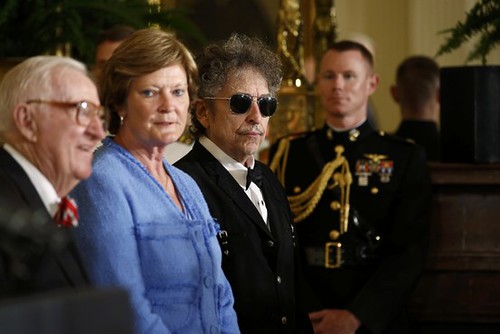
Musician Bob Dylan stands with fellow Presidential Medal of Freedom recipients former Associate Justice of the U.S. Supreme Court John Paul Stevens and former University of Tennessee basketball coach Pat Summitt in the East Room of the White House in Washington
To read the complete article, see: Text, Photos: Obama's Medal of Freedom Presentations (blogs.wsj.com/washwire/2012/05/29/text-photos-obamas-medal-of-freedom-presentations/)
To read the complete article, see: US President Obama risks feud with Poland over Polish war hero medal honour gaffe (www.ejpress.org/article/58560)
ARTICLE INTERVIEWS HOBO NICKEL COLLECTION BUYER
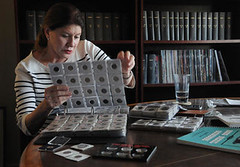 In 2003, Candace DeMarco Kagin of Tiburon was walking through a coin show
when she saw a nickel carved with the image of a golf caddy wearing a long, cutaway coat.
In 2003, Candace DeMarco Kagin of Tiburon was walking through a coin show
when she saw a nickel carved with the image of a golf caddy wearing a long, cutaway coat.
It turned out the coin was an original buffalo nickel that had been re-configured at the hand of a Depression-era hobo. The coin, Kagin learned, was part of a tradition of so-called "hobo nickels," which jobless men carved in exchange for a meal or a place to sleep as they roamed the country in search of work.
"A lot of them were very well educated but just couldn't work during the Depression era," said Kagin, a retired manager for Visa Inc. who is married to well-known Tiburon coin expert Don Kagin.
She was instantly hooked, and over the past decade she has collected hundreds of the nickels. This month she paid $170,000 for a collection of 218 coins at a collectors' show in Denver, Colo., nearly doubling her collection to more than 500 hobo nickels and grabbing the attention of enthusiasts.
"Now she has the number one hobo nickel collection in the world," said H. Robert Campbell, a Salt Lake City, Utah coin dealer who brokered the sale. "When you hold one of these in your hand it's like history in your hands. It tells a story. It's intriguing. And that's what gets people collecting."
Carved mostly during the Great Depression, hobo nickels became a way for out-of-work men to receive food or shelter without asking for a free handout, Campbell said. The men used crude handmade chisels, files and other tools to re-configure buffalo nickels, which were minted from 1913-38 and featured an Indian head on one side and a buffalo on the other.
The most common engravings depict profile portraits of men, but others feature animals such as turtles and elephants or objects such as boxcars.
Few carvers' names are known, and some carvers have been given nicknames based on features of their work, such as "Scruffy Beards" or "Peanut Ears."
Kagin's collection now includes work by some 30 different artists, including two of the only carvers known by name -- George Washington "Bo" Hughes and his mentor, Bertram "Bert" Wiegand. The two men are considered the masters of the craft, and a carving by Weigand recently sold for $12,500, a record price for a single hobo nickel, according to the magazine Coin World.
To read the complete article, see: With $170,000 buy, Tiburon woman amasses world's top 'hobo nickel' collection (www.mercurynews.com/breaking-news/ci_20733318/170-000-buy-tiburon-woman-amasses-worlds-top)

2012 MEMPHIS INTERNATIONAL PAPER MONEY SHOW SPEAKERS
The speakers series for the 2012 Memphis International Paper Money Show to be held June 8-10 has shaped up to be particularly strong this year with a diverse range of topics so there is something for everyone. The Nation's top researchers and speakers are on board.
Speaker Series Schedule:
Friday, June 8th
10:00 a.m. 19th Century Counterfeits - Sullivan
11:00 a.m. Short Snorters and Other Numismatic Souvenirs of WWII - Fellers
12:00 noon Seal Varieties on backs of 1875 & 1882 Natls - Huntoon & Shiva
1:00 p.m. Currencies N. Vietnam during the American War - Daniel & Urce
2:00 p.m. Official Counterfeiting - Boling
3:00 p.m. Birth of Confederate Paper Money - Wolka
Saturday, June 9th
10:00 a.m. New Natl Bank Note Census - Shiva
11:00 a.m. $1 Legal Tender 1928 Red Seals - Yakes
12:00 noon Paper Money of Palestine and Israel - Chambliss
1:00 p.m. Inside the Treasury - Loftus
2:00 p.m. Series of 1929 Replacement Notes - Simek
3:00 p.m. $5 Series of 1882 BB Title Block - Huntoon
Official Counterfeiting
By Joseph E. Boling
Official counterfeiting is government-against-government. As you would expect, this most often happens in times of war, although sometimes it goes on without hostilities. Probably the most famous instance is the German counterfeiting of British "white" notes during WWII, but there are many more examples. Even the US has been involved in faking notes of other issuers. This talk will cover as many cases as we can squeeze into fifty minutes.
Paper Money of Palestine and Israel
By Carlton Chambliss
In 1927 Palestine Currency Board was established under the control of the Bank of England within the Palestine and Transjordan mandate authorized by the League of Nations after World War I. The Board issued notes in 6 values. The United Nations partitioned the region into Jewish and Arab states in 1947. The Zionists created Israel in 1948 upon the departure of the British. The private Anglo-Palestine Bank developed two sets of notes for use in Israel, an unissued provisional series printed in Tel Aviv and an issued series printed by the American Bank Note Company. The Anglo-Palestine Bank was renamed Bank Leumi Le-Israel in 1951, and notes were issued with the new title in 1952, at the same time the 1948 issues were retired. The government Bank of Israel was organized in 1954, and it has issued all Israeli coins and currency since 1955. Bank of Israel issues are rich in variety.
Currencies of North Vietnam during the American War
By Howard Daniel and Roger Urce
We'll profile and illustrate specimens, issued currency and coins used in North Vietnam during the Vietnam War. We're particularly delighted to show you pieces not listed in the Standard Catalog of World Paper Money. These two guys are in-country mining this stuff from recesses you never dreamed of.
Short Snorters and Other Numismatic Souvenirs of WWII
By Ray and Steve Feller
In this fully illustrated talk we will discuss wonderfully interesting notes and tokens that were saved as souvenirs from WWII. We will start with Short Snorters- notes featuring signatures of WWII comrades. We will share stories about the people behind the signatures, including some famous folk. We will also discuss other numismatically- themed souvenirs from the war, some amusing and others deeply powerful.
Inside the Treasury - National Bank Notes from Behind the Scenes
By Lee Lofthus
Get an insider's look at the real-world operational stresses that forced several prominent design features to appear and disappear from the faces of large size National Bank Notes. See how the layouts on small size nationals almost came out vastly different than they did. Have you ever heard of the bad fire that caused a shower of $10,000 gold notes? Come inside the Treasury Department to the days of national banking through authentic vintage photographs never before seen in the numismatic press. After you see this, you'll never look at your notes quite the same as you did before!
$5 Series of 1882 Brown Back Title Block Layouts
By Peter Huntoon
No canvas ever was used more effectively to display bank titles than the spacious faces of $5 Series of 1882 nationals. Huntoon has seen every proof made for the series and will show you every great layout that ever was made, plus some that weren't so great!
State and Territorial Seal Varieties on the Backs of Series 1875 and 1882 Nationals
By Peter Huntoon (presenter) & Andrew Shiva
The cutting edge research that will be unveiled here will reveal previously unexpected and undocumented varieties on numerous state seals on issued national bank notes. In addition you will be amazed to learn there are seals that were used but have never been seen on surviving specimens. The beautiful seals that you love to collect are not a cut-and-dry curiosity about which everything has been written, but rather they represent a pursuit that requires a serious second look.
The New National Bank Note Census - Hickman/Kelly/Gengerke/Huntoon rolled into one
By Andrew Shiva, National Currency Foundation
Dealers and collectors this is hot! National Currency Foundation organizer Andrew Shiva will explain what the foundation is all about and its goals, and how it will operate the revolutionary new interactive online National Bank Note census. You'll see by means of a projected interactive display that the census already is available online, just how comprehensive it is, and how easy it is to use. We are now at 356,000+ reported notes and growing fast.
Series of 1929 Replacement Notes
By James Simek
Misprinted Series of 1929 national bank notes discovered at the Bureau of Engraving and Printing were replaced with make-up notes, not star notes. The replacements were made and substituted in 6-subject sheet form. The Nation's leading authority on 1929 replacement notes will use a lavishly illustrated presentation to explain everything about them including why they were used instead of star notes, how they were made, how you can identify them and which varieties are scarce or rare.
19th Century Counterfeit Currency Detection and Prevention Literature
By Michael Sullivan
This presentation provides an overview of 19th century literature devoted to counterfeit currency detection. American works will be emphasized with select British material included because the two nations employed similar technologies to ward off counterfeiting. Important people involved in bank note engraving technology and counterfeit prevention such as Congreve, Dye, Heath, Hodges, Perkins and Thompson will be discussed. The presentation is augmented by a superb parallel exhibit of 19th century counterfeit detection publications.
The Birth of Confederate Paper Money
By Wendell Wolka
The intriguing story will be told of how Confederate paper money and bonds were ordered, produced and shipped to the South at the start of the Civil War.
The Complete Story of the $1 Legal Tender 1928 Red Seals
By Jamie Yakes
The Series of 1928 $1 United States Notes are at the top of the list of avidly collected small-size type notes. Their beauty coupled with their flash-in-the-pan issue greatly boosts their allure. Despite this, very little is known about them. This presentation will tell their story from A to Z: Why the Treasury thought they needed them, when they were printed, and when and where they circulated. Plus, learn why Puerto Rico factored into their story.
For more information, see: www.memphisipms.com
Ray Czahor adds:
COINS LEFT ON HEADSTONES
While visiting some cemeteries you may notice that headstones marking certain graves have coins on them, left by previous visitors to the grave.
These coins have distinct meanings when left on the headstones of those who gave their life while serving in America's military, & these meanings vary depending on the denomination of coin.
A coin left on a headstone or at the grave site is meant as a message to the deceased soldier's family that someone else has visited the grave to pay respect. Leaving a penny at the grave means simply that you visited.
A nickel indicates that you & the deceased trained at boot camp together, while a dime means you served with him in some capacity. By leaving a quarter at the grave, you are telling the family that you were with the soldier when he was killed. According to tradition, the money left at graves in national cemeteries & state veterans cemeteries is eventually collected, & the funds are put toward maintaining the cemetery or paying burial costs for indigent veterans.
In the U.S., this practice became common during the Vietnam war, due to the political divide in the country over the war; leaving a coin was seen as a more practical way to communicate that you had visited the grave than contacting the soldier's family, which could devolve into an uncomfortable argument over politics relating to the war. Some Vietnam veterans would leave coins as a "down payment" to buy their fallen comrades a beer or play a hand of cards when they would finally be reunited.
The tradition of leaving coins on the headstones of military men & women can be traced to as far back as the Roman Empire.
ARTICLE HIGHLIGHTS WEST POINT FIRST SALUTE SILVER DOLLAR TRADITION
 Cadet Charles Anthony Long, son of Dr. James R. and Lisa Long of Newnan, graduated from the U.S. Military Academy May 26.
Cadet Charles Anthony Long, son of Dr. James R. and Lisa Long of Newnan, graduated from the U.S. Military Academy May 26.
Long's West Point graduation announcement reads like thousands of others, but one poignant moment set his ceremony apart from most. It wasn't when United States Vice President Joe Biden gave his keynote speech, or the precise maneuvers of the cadets, or even the hat toss. It was when his younger brother John - a "firstie," or West Point senior - gave him his first salute.
"I think it was fitting for John to give me my first salute since 358 days from now he will be a second lieutenant as well," Long said. "We have a tradition at West Point to give your first salute a silver dollar. That silver dollar is supposed to be in memory of the person you saluted as they go off into the army. A cadet keeps the silver dollar to remember what they are in training to become."
To read the complete article, see: First Salute: Coweta County's Long family continues West Point tradition (www.times-herald.com/local/20120603-CharlesLongWPointGrad-MOS)
ALEXANDER HAMILTON, FEDERALIST HUNK
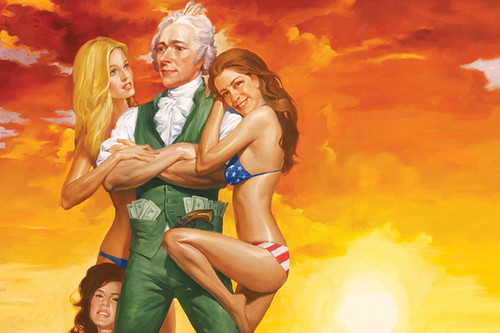
Alexander Hamilton was a stud. Yes, he served as George Washington's aide-de-camp during the Revolutionary War, wrote a majority of the Federalist Papers, became the first U.S. Secretary of the Treasury, and was the father of American finance-but he was also a quick-tempered, egotistical flirt who caused America's first political sex scandal and died tragically in a duel against Aaron Burr in 1804.
But it's not just his brilliant political mind that has seduced people. Hamilton was a slender, fair-skinned, auburn-haired man with a chiseled jaw and azure eyes so alluring that Massachusetts representative Fisher Ames once called them "eminently beautiful." Henry Cabot Lodge described him as "very attractive," while a flustered Abigail Adams once wrote to her husband that Hamilton represented "lasciviousness itself." Or, as a woman named Breanna Lynn more recently put it on Facebook, "I'd tap that."
Lynn posted this message on the Facebook group "Alexander Hamilton Was the Foxiest of the Federalists," just one of a string of Hamilton fan pages that have cropped up on the social network. Others have names such as: "I love Alexander Hamilton," "Alexander Hamilton?...?The Hotness Never Dies," "Are you Treasurer Sexy?" and "Alexander Hamilton: Too Hot For Your Wallet." There are Tumblrs, Twitter accounts, and fan fiction communities dedicated to the patron saint of Wall Street. A year ago, Rod Blagojevich admitted to having "a man crush" on him.
"Just Google 'Alexander Hamilton Is Hot' and you'll be surprised [by what] you get," says Caroline Hamilton (no relation), an English lecturer at the University of Pittsburgh who has written about Hamilton's modern-day popularity. "Interest in Hamilton has really come back."
A number of Hamilton appreciation groups are preoccupied with how dashing he looks on the $10 bill, which was redesigned in 2005. The oval around Hamilton's portrait was removed, his shoulders were broadened, his face given more prominence. "He looks like he's been Hollywoodized," says biographer Chernow. "The Treasury Department in all its wisdom has turned him into a real hunk."
Similar updates have been made to other denominations, but only Hamilton's has inspired lustful swoons. "The new bill uses the same portrait as before," says Douglas Mudd, curator of the American Numismatic Association's Money Museum in Colorado Springs. "But now it's a little bit more friendly-looking. Aside from his hairdo, you could easily imagine him being a modern person."
Hamilton's rags-to-riches story is a big part of his mystique. He was born on the Caribbean island of Nevis in either 1755 or 1757 to parents who never married. After his father left and his mother died, Hamilton worked as a clerk in Danish-controlled St. Croix. He was still a teenager in 1772 when he published a moving essay on St. Croix's near-destruction by a hurricane; it so impressed local leaders that they raised money to send Hamilton to school in New York. Within five years, the upstart was working alongside George Washington and operating in some of the most prestigious social and political circles in what was to become the United States. "He is the classic American success story. He comes out of nowhere, recreates himself, and sets the world on fire," says Chernow. "He was the Elvis Presley of his time."
To read the complete article, see: Alexander Hamilton, Federalist Hunk (mobile.businessweek.com/articles/2012-05-31/alexander-hamilton-federalist-hunk)
CANADIAN CHARITIES CHASING CLOSETED CENTS
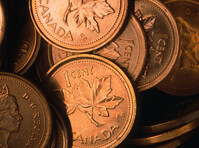 One of the strongest reasons not to abolish low-value coins -- cents in particular -- was that charities would lose the coin most often donated to their organizations.
One of the strongest reasons not to abolish low-value coins -- cents in particular -- was that charities would lose the coin most often donated to their organizations.
Now that Canada has abolished their cent coin, Canadian charities are launching, as expected, fund-raising campaigns for donations of the idle cents no longer useful for making purchases. In Sudbury, one of the first of these campaigns, is seeking ten million cent coins to underwrite the cost of a therapeutic pool at a health center clinic.
The campaign began with school children, with selected industries targeted next, including construction and mining sectors. The goal of obtaining 10 million cents is ambitious, but now that the cents are obsolete this can be a strong reason to gather those from the top of dressers, stored in jars and boxes, or even squirreled away in closets.
After all the cents are taken out of circulation charities might even learn that donations might increase with only higher coin denominations available.
Here is the Sudbury story seeking 10 million cents: Needed: 10 million pennies (www.thesudburystar.com/ArticleDisplay.aspx?e=3572730)
THE BOOK BAZARRE
MANY THANKS TO ALL OUR BIDDERS FORMAKING MAIL BID SALE NO. 16 A SUCCESS
DAVID SKLOW - FINE NUMISMATIC BOOKS
www.finenumismaticbooks.com
Mail Bid Sale No. 17 Closes OCTOBER 6, 2012
EAST INDIA COMPANY SELLING DIAMOND-ENCRUSTED COINS FOR QUEEN'S JUBILEE
Stephen Pradier writes:
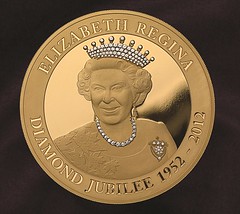 Forget commemorative mugs or tea towels, there's now a much more elaborate souvenir on sale to mark the Queen's diamond jubilee.
Forget commemorative mugs or tea towels, there's now a much more elaborate souvenir on sale to mark the Queen's diamond jubilee.
But with a price tag of £125,000, you'll need more money than taste in order to afford it.
The East India Company has released 60 minted gold coins, one for each year of Queen Elizabeth II's reign, encrusted with diamonds to celebrate the royal milestone.
Despite the hefty price tag, the company has revealed that it has had 'brisk and determined interest' from monarchist collectors and investors from across the globe.
Each kilo struck by The Royal Mint represents over 1,000 hours of craftsmanship - and the company has received particularly high interest in the coins from international buyers.
As a result, the company is now scheduling private viewings in Monaco, Moscow, Geneva, Hong Kong, the Middle East and India.
The East India Company, which has a flagship store in Mayfair, has long-standing links to the British monarchy.
Sanjiv Mehta, CEO of East India Company said: 'The company was instrumental in building the British Empire with its legacy still visible today in what we know as the Commonwealth Nations.
'We chose to commission the Royal Mint, another quintessential British brand who first minted coins for us over 200 years ago, with this unique project to create a timeless tribute that reflects the grand achievement it celebrates.'
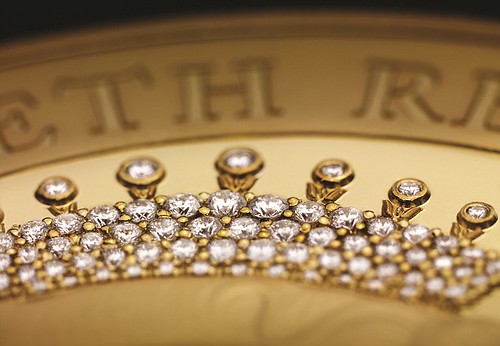
To read the complete article, see:
For those with more money than taste... the £125,000 diamond encrusted gold coins on sale to celebrate Queen's jubilee
(www.dailymail.co.uk/femail/article-2151616/125k-diamond-encrusted-gold
-coins-sale-celebrate-Queens-Diamond-Jubilee.html)
ARTICLE HIGHLIGHTS MINNESOTA ELONGATED CENTS
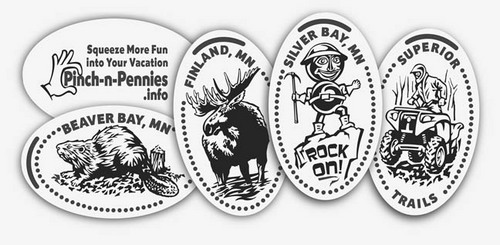
They are called by many names – elongated coins, pressed pennies, flattened pennies, and pinched pennies. They made their first appearance at the Chicago World's Fair in 1893 and will appear in Silver Bay this summer.
A new "penny press" machine will be located in the lobby of the Silver Bay AmericInn Hotel beginning this Memorial Day weekend.
The made-in-Minnesota penny press machine features four images by artist Gary Baune, originally from Silver Bay. Two quarters are inserted along with a penny. A hand crank is then used to force the penny through high-pressure steel rollers that imprint a custom design onto the coin.
The result is an inexpensive, unique, local copper memento. Brand-new, bright, shiny, uncirculated pennies will be available onsite for the first Bay Area "penny pinchers."
To read the complete article, see: Cents of local pride: Pinched penny options to expand in Silver Bay (www.twoharborsmn.com/event/article/id/23558/)
FEATURED WEB SITE: THE GLOBAL PHILATELIC LIBRARY
This week's Featured Web Site is the Global Philatelic Library, a joint web site offering access to online literature about our cousin hobby, stamps. Here's an item about it from Art Daily
The Smithsonian's National Postal Museum announces the launch of the Global Philatelic Library website, a centralized information gateway to the world's greatest philatelic research. Founding partners include the National Postal Museum and Smithsonian Libraries in Washington, D.C., the Royal Philatelic Society London and the American Philatelic Research Library in Bellefonte, Pa.
On Feb. 15, 1888, American Philatelic Association President John K. Tiffany wrote to Edward Denny Bacon, secretary of the then Philatelic Society London, regarding a joint indexing project. He said, "…I consider the project as utterly impossible of any practical execution..." One hundred and twenty-four years later the project has become a reality. This ambitious project has become a present-day reality thanks to the inspiration and dedication of the founding partners. The website establishes a single destination–a responsive centralized gateway–by which philatelists around the world can search, locate and access philatelic research from partner libraries in real time, from any computer. Searchable listings of books and publications, as well as resource locations and access, are now just a click away, providing invaluable resources to those doing philatelic research.
• World-class collection of printed, electronic and other media
• Access and support for beginners, hobbyists, specialists, writers and postal historians
• International collaboration and cooperation with philatelic libraries and museums around the world
• Anthology of fascinating, informative and sometimes even scandalous articles written throughout the past century about philately and some of the people involved in its history
"A large part of the philatelic information I have acquired was discovered incidentally while searching for something else," said Thomas Lera, Winton M. Blount Research Chair at the National Postal Museum. "I hope other philatelists, scholars and researchers will push open the doors of the new global philatelic library to find the answers to their questions and uncover new ones in the process as well."
Other contributing philatelic research libraries include The Collectors Club Library in New York, Greene Foundation (Canada), Oslo Filatelistklubb Bibliotek (Norway), Philatelistische Bibliothek Hamburg (Germany), Postal History Foundation in Tucson, Ariz., Rocky Mountain Philatelic Library in Denver, National Philatelic Society (United Kingdom) and Western Philatelic Library in Sunnyvale, Calif.
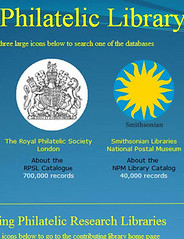
www.artdaily.org/index.asp?int_sec=2&int_new=55805
